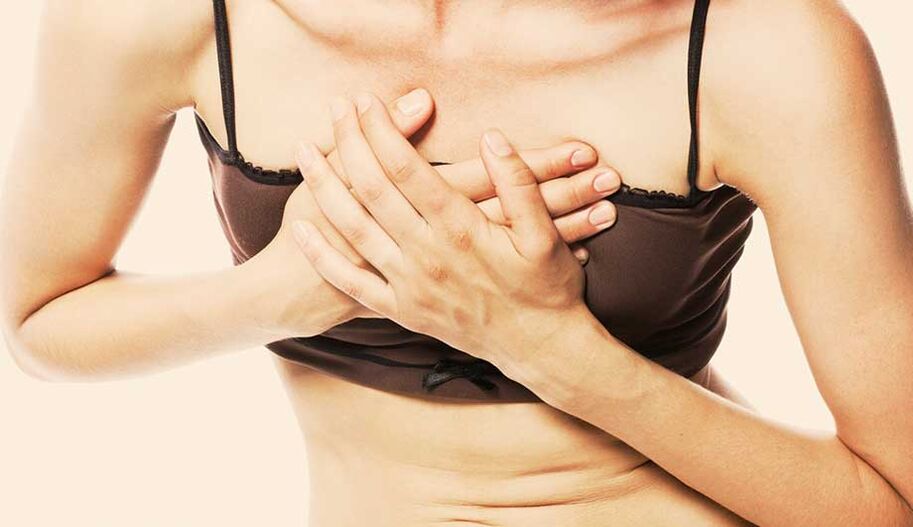Osteochondrosis is a very dangerous disease. It occurs invisibly and from mild unpleasant sensations develop into serious spinal disorders, which sometimes result in disability.

Therapists, neurologists, orthopedists, vertebrologists and other specialists are involved in treating this disease.
Symptoms and sensations of chest osteochondrosis
Osteochondrosis of the thoracic spine is less common than osteochondrosis of the cervical or lumbar spine. The thoracic vertebrae are less mobile and more protected. This disease is complicated by the fact that the symptoms are difficult to identify, and then this can lead to a number of other diseases.
One of the main reasons for the occurrence of osteochondrosis in the chest region is the presence of scoliosis in humans. With the curvature of the spine, the pressure on the vertebrae increases and there is their displacement and loss of discs from the spine. The pain that occurs with this disease is indicated by the fact that changes occur in the vertebrae, metabolism and blood supply are disrupted. This disease mainly affects people who lead a sedentary lifestyle, office workers, drivers, students.
With thoracic osteochondrosis, the symptoms and sensations are divided into the main pain syndromes: dorsago and dorsalgia. Dorsalgia is a prolonged chronic pain that is mild and brings little discomfort to the patient. Dorsago is a sudden, sharp pain. Occurs when a person is in a certain position for a long time and changes it dramatically. Shortness of breath may occur, it becomes difficult to breathe, the muscles are poorly controlled.
Degenerative thoracic disc disease: symptoms and sensations are typical and atypical
Osteochondrosis of the thoracic region, like any other disease, has a number of characteristic features. List of typical symptoms:
- painful sensations intensify when you inhale, turn your body, raise your arms up;
- the pain starts in one place, and then spreads rapidly throughout the chest area. Difficulty breathing. The patient is obliged to seek a comfortable position. Neuralgia occurs between the ribs;
- muscles are very tense, spasms occur periodically;
- precursor of intercostal neuralgia is recurrent pain, discomfort in the back and chest that occurs when walking or exercising;
- pain syndrome intensifies at night, by morning it may subside completely. It becomes pronounced even during hypothermia.
For osteochondrosis of the chest region, the symptoms and sensations are characteristic that are characteristic of other diseases. Such symptoms are called atypical. This includes:
- painful sensations similar to diseases of the cardiovascular system. When you take medication, there is no improvement, it may even worsen your health condition. Also, with an ECG, no changes are noticed;
- for women in the acute stage of disease development, mammary gland pain is characteristic. You can rule out this pathology by visiting a mammologist;
- sometimes patients complain of painful sensations similar to pain in gastritis, ulcers, diseases of the gastrointestinal tract. But, unlike these diseases, with osteochondrosis, the pain intensifies during moments of power loads, and not when eating;
- disorders of the urinary and reproductive systems;
- some patients experience difficulty swallowing the reflex, a feeling of "lump in the throat. "
With chest osteochondrosis, treatment is required immediately, and self-medication is unacceptable. This can lead to a deterioration of the patient's condition, and subsequently to disability. Specialists can recognize the typical and atypical symptoms of the disease. Qualified doctors diagnose thoracic osteochondrosis using modern equipment and treat them using the latest effective methods.
Chest osteochondrosis: symptoms and treatment
The hospital uses the best schemes and methods for treating osteochondrosis in the chest. The method of medication helps to eliminate the inflammatory process and relieve pain. The main method of treating osteochondrosis is the use of chondroprotectors for a long period of time. They restore the cartilage of the intervertebral discs, their elasticity. For hospitalized patients, a prerequisite for treatment is exercise therapy to strengthen the musculo-ligamentous framework. Muscle relaxants (relieve muscle spasms), non-steroidal anti-inflammatory drugs are used.
To maintain overall balance, to improve metabolism in the body, proper nutrition is needed. The hospital offers the services of a nutritionist and hospital wards, where it is much easier to maintain a healthy lifestyle during the recovery period than at home.
Among the additional treatment methods used are:
- acupuncture;
- massages;
- physiotherapy;
- manual therapy;
- vacuum therapy.























